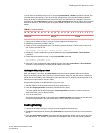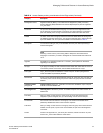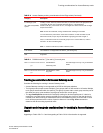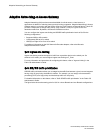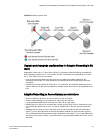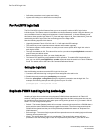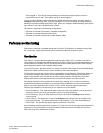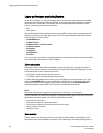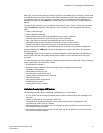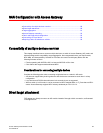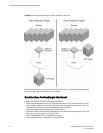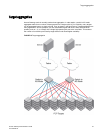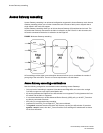device logged in. The first login takes precedence over the second login request in case of a
duplicate entry exit on the F_Port without any NPIV device logged in.
You can configure different handling of duplicate PWWNs other than the default operation using the
configure command through the F_Port login parameters. For more information on configuration and
handling of duplicate PWWNs during device login, refer to the "Duplicate PWWN handling during device
login" section in the Fabric OS Administrator’s Guide .
This feature is supported in the following configurations:
• AG switch connected to AG switch in cascaded configuration.
• AG switch connected to Brocade fabric switch.
• AG switch connected to a Brocade Host Bus Adapter (HBA).
Performance Monitoring
Performance monitoring is available through the Flow Vision "Flow Monitor" for platforms using Fabric
OS 7.2 and later. Legacy Advanced Performance Monitoring features are also an option.
Flow Monitor
Flow Vision is a licensed feature supported on platforms using Fabric OS 7.2 and later. It provides a
unified platform to manage traffic-related applications on Fabric OS devices. Storage administrators can
use this platform to simulate, monitor, and capture the network’s traffic patterns and to make capacity-
planning decisions based on the collected statistical data.
To access Flow Vision, the Fabric Vision (FV) license or both the Fabric Watch (FW) and the Advanced
Performance Monitor (APM) licenses must be installed on the hardware platform.
The Flow Monitor component of Flow Vision is supported by Access Gateway. Flow Monitor allows you
to monitor the network’s traffic pattern and provides statistics to make capacity planning decisions
based on the collected data. Flow Monitor provides a single interface to manage flows and unifies
different performance monitoring features such as end-to-end monitors and frame monitors.
Flow Monitor expands on basic performance monitoring by allowing you to monitor any hardware-
supported flow parameters and define your own flows using combinations of source and destination
devices, source and destination IDs, LUN IDs, CSCTL values, and frame types as parameters.
Following are examples of monitors that you can replicate using Flow Monitor:
• End to End Monitor - This measures the traffic in terms of word count between a pair of ports (host
and target). Use this to view end-to end traffic values on an Access Gateway.
• Frame monitoring - Set up an SCSI monitor so that you can view the -frametype frame and byte
count for a flow.
• LUN monitoring - This allows you to view the -frametype frame and byte count for a specific LUN.
• Flow learning monitor - This learns flows going through a specific F_Port in the Access Gateway.
• DST monitor - This provides the legacy support equivalent to a fmmonitor.
Access Gateway switches support flow monitors on F_Ports only, and only the ingress port parameter is
supported. For more information on using Flow Monitor features for Access Gateway in Flow Vision,
refer to the Flow Vision Administrator's Guide .
Performance Monitoring
Access Gateway Administrator's Guide 85
53-1003126-02



